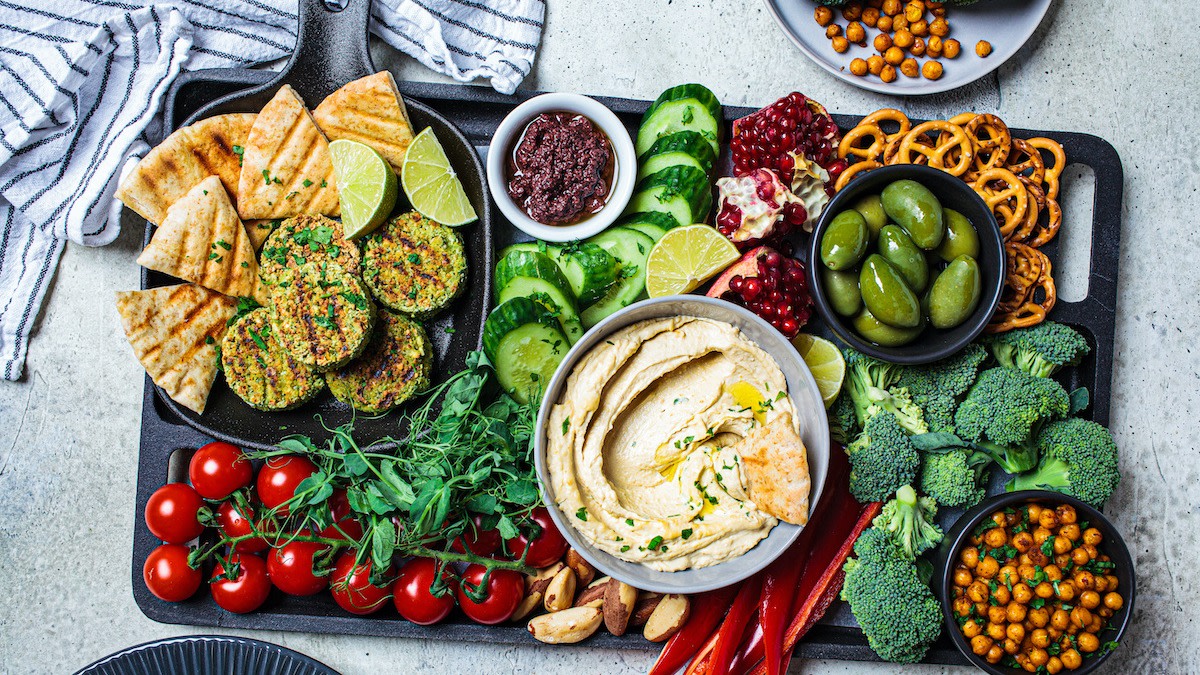How to Make a Vegetarian Charcuterie Board
Written by MasterClass
Last updated: Mar 28, 2022 • 4 min read
A vegetarian charcuterie board is an arrangement of appetizers on a serving platter or wooden board. Lay out fresh fruit, veggies, and a cheese board to create a colorful and dynamic spread of appetizers.
Learn From the Best
What Is a Vegetarian Charcuterie Board?
A vegetarian charcuterie board is an appetizer platter made up of cheeses, fruits, vegetables, nuts, spreads, dips, and crackers. The food items for a charcuterie platter are typically placed on a wooden board. Vegetarian charcuterie boards often feature chopped vegetables, cheeses, dips, dried fruits, and other non-meat food options. Hosts and chefs can also create vegan snack boards with veggies, vegan meats, tapenade, and other non-animal foods.
The French word charcuterie means “pork butcher shop” and was first used to describe stores in France that sold cured pork products, similar to the modern-day delicatessen. Today, charcuterie can refer to many types of cured meat, including Italian cured meats like soppressata and prosciutto. It can also refer to an arrangement of sweet and savory vegetarian appetizer options such as fruits, cheeses, and vegetables.
10 Foods for a Vegetarian Charcuterie Board
You can customize a vegetarian snack board to your taste. The options are endless, so flesh out your charcuterie board ideas with these nosh options below:
- 1. Berries: A cluster of raspberries, blueberries, blackberries, and strawberries go well with a spring or summer board.
- 2. Bread: You may want to cut up a baguette to go with your veggie board—slice the bread into thin pieces so guests can spread soft cheeses or hummus on top. You can also bake the slices with a brush of garlic and olive oil to make homemade crispy crostini.
- 3. Cherry tomatoes: Especially when fresh in the summer, these smaller, sweeter tomatoes make an excellent addition to your veggie charcuterie.
- 4. Cheeses: It’s good to have a couple of different kinds of cheese on your board to give options. A classic cheddar, a softer brie, and a funkier blue make for a trio of cheeses that provide something for everyone to enjoy.
- 5. Chopped bell peppers: Colorful bell peppers—in reds, greens, yellows, oranges, and more—add a healthy mix to your board.
- 6. Crackers: A variety of crackers (plain and flavored) in different shapes (rounded and rectangular) can give visual variety to your board.
- 7. Dips: A side of hummus or vegetable dip gives your guests a way to enjoy their veggies and crackers.
- 8. Dried fruits: Add some dried apricots, dates, and cranberries to sweeten your mix of foods.
- 9. Nuts: If none of your guests have nut allergies, a bowl of peanuts, pistachios, cashews, or almonds can add a salty addition to your meat-free board.
- 10. Radishes: These more bitter veggies pair well with an onion dip to help soften their bite.
7 Tips for Assembling a Charcuterie Board
Follow these tips to make a delicious and aesthetically pleasing board:
- 1. Gather your ingredients. You may run to the grocery store for produce and the deli for your cheeses; seek out what looks fresh, colorful, and is in season.
- 2. Give yourself an hour of prep time. Most of the work with creating your vegetarian or vegan charcuterie board will involve chopping up the produce after rinsing and drying it. Depending on the size and scope of your board, you may want to set an entire hour aside, and the total time may be longer if you are creating homemade dips or roasting nuts, like pecans or hazelnuts.
- 3. Organize food by type. You’ll want to have veggies with veggies and fruits with fruits; of course, you can have these food groups neighboring each other on the board, but to best preserve their flavors and enhance your presentation, you’ll want to plate categorically.
- 4. Fan out your foods. You’ll want each individual food on your beautiful board to be easily accessible for guests and friends. Overlay crackers, apple slices, or chopped bell peppers over one another so that the topmost one is always available and easy for picking.
- 5. Use small bowls. Some goodies won’t fit on your board, so you may put smaller items like olives or cranberries into bowls that add a pop of color and varying levels to your grazing board. You can also use bowls for dips like hummus—be sure to place bowls near the items dipped into them, such as crackers, red pepper, or celery.
- 6. Play with patterns and color. You may organize parts of your board, when appropriate. For example, you might organize the board by color, such as putting cherries and strawberries near one another since both are red fruits. You can also create fun patterns, like abutting curved lines or esses out of cubed cheese or blackberries trails.
- 7. Label sections as needed. You may have some guests who abide by gluten-free or dairy-free diets. Make it easy for these guests to find food that is safe for them to eat by labeling the dairy-free cheeses and crackers without whole grains with small signs.
Want to Learn More About Cooking?
Become a better chef with the MasterClass Annual Membership. Gain access to exclusive video lessons taught by the world’s best, including Dominique Crenn, Gabriela Cámara, Joanne Chang, Alice Waters, Mashama Bailey, Niki Nakayama, and more.
